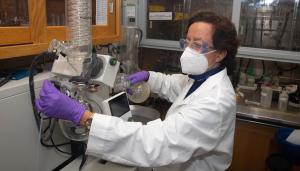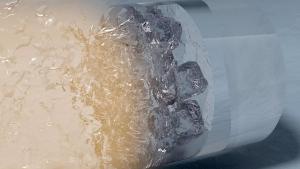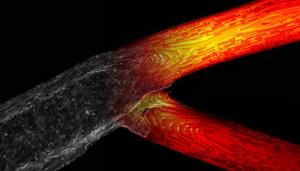LAB REPORT
Science and Technology Making Headlines
Dec. 3, 2021


Illustration of NASA’s DART spacecraft and the Italian Space Agency’s LICIACube prior to impact at the Didymos binary system. Credits: NASA/Johns Hopkins, APL/Steve Gribben.
Hitting an asteroid with a DART
Last week, NASA launched a multimillion-dollar spacecraft — to slam into an asteroid. Rather than being a catastrophic error, however, it will be the first test of a way to protect Earth from killer asteroids.
The asteroid that NASA is smashing into, called Dimorphos, is not a threat to Earth. But researchers want to see whether they can change its trajectory, long before they might need to use such a strategy to deflect a truly dangerous asteroid.
Lawrence Livermore is taking part in NASA’s first-ever planetary defense test. The Double Asteroid Redirection Test (DART) will examine technologies that will prevent an impact of Earth by a hazardous asteroid. DART is the first demonstration of the kinetic impactor technique to change the motion of an asteroid in space. The asteroid is a small moon of a larger asteroid called Didymos. The impact into Dimorphos does not pose any danger to Earth.
LLNL’s role as participants in the DART mission include a working group focused on modeling the impact and deflection of the asteroid.


Ana Racoveanu synthesizes energetic compounds with isotopic labels to help make munitions safe to handle and use. Photo by Julie Russell/LLNL.
She's energizing
Ana Racoveanu is able to do something most others throughout the nuclear security enterprise cannot do — something challenging and extremely valuable throughout the complex.
Racoveanu, a staff scientist in Lawrence Livermore National Laboratory's Materials Science Division, can synthesize energetic compounds with isotopic labels.
The primary goal of this work is to make munitions safe to handle and use. Isotopic labeling is when a specific type of atom, such as a nitrogen, is replaced with a nitrogen of a different isotope. Successful synthesis of labeled energetic materials facilitates the understanding of the fundamental science of explosives.


Researchers used the same set-up at the recent study to create superionic ice, shown here in this artistic rendering. In that instance, the ice was not stable. Image credit: Lawrence Livermore National Laboratory illustration / Marius Millot, Federica Coppari, Sebastien Hamel and Liam Krauss.
A new state of matter
Scientists just squeezed a water droplet between two diamonds and blasted it to star-like temperatures with one of the world's most powerful lasers. The result was a new and mysterious phase of water.
Called superionic ice, the “strange, black” water exists under the same pressures and temperatures as those at the center of Earth — a fact that could soon help researchers investigate the secrets buried inside the cores of other worlds.
Previously, Lawrence Livermore researchers used shock waves to create this weird ice for just 20 nanoseconds before it dissolved. This new experiment marks the first time that scientists have created stable superionic ice that lasts long enough to be studied in detail.


Researchers at Lawrence Livermore National Laboratory and Duke University combined 3D bioprinting and computational flow models to analyze the physics behind circulating tumor cell behavior and the cells’ attachment to the vascular endothelium, the layer of cells that line the interior surface of blood vessels. Visualization by Claire Robertson/LLNL.
Advancing cancer treatment with 3D printing
With cancer deaths predicted to top 16 million by 2040, researchers and scientists are increasingly looking at how technologies like 3D bioprinting can aid diagnosis and drug development for cancer patients.
Lawrence Livermore scientists have investigated how combining 3D bioprinting with computational flow simulations can provide a better understanding of how cancerous tumors are formed.
The team paired 3D-printed, living human brain vasculature with advanced computational flow simulations to better understand tumor cell attachment to blood vessels, the first step in secondary tumor formation during cancer metastasis. The unique approach, developed with outside collaborators, lays the foundation for developing a predictive capability that can help clinicians and researchers anticipate the spread of cancer within individual patients.





